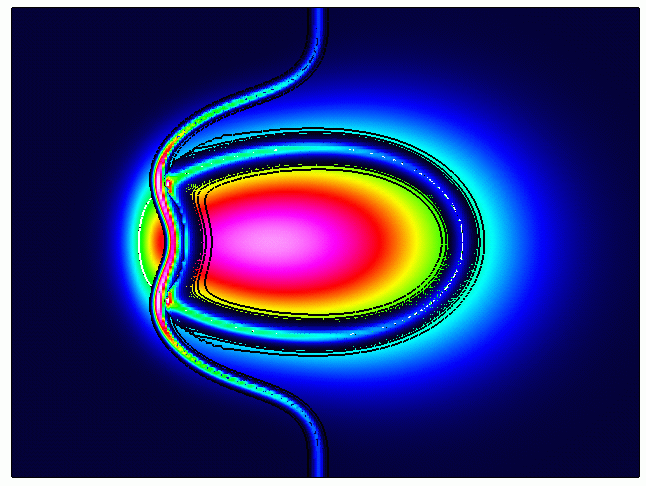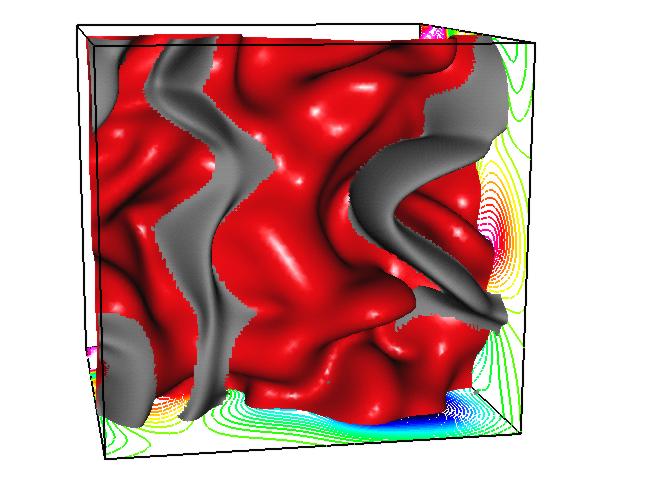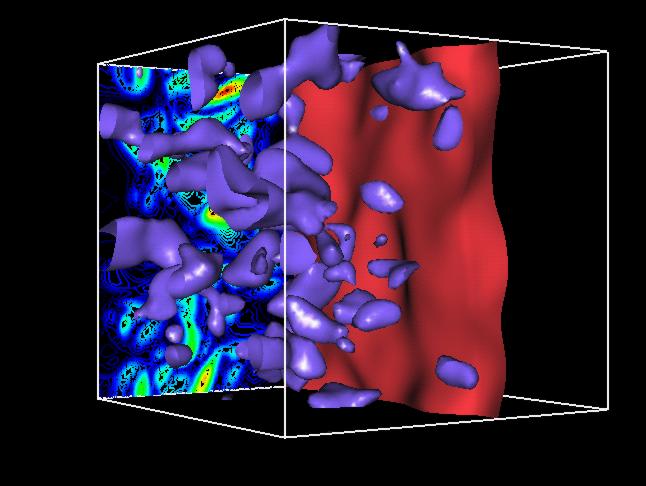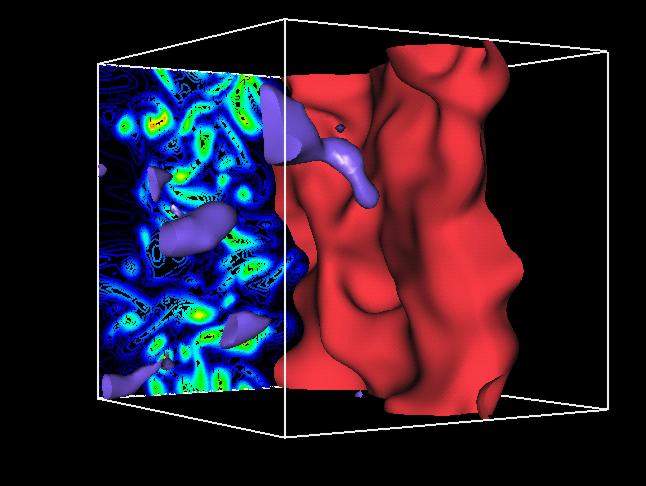
THESIS:
Direct simulation and modelisation of premixed flame propagation in heterogeneous or stratified mixture.

Abstract
The technological context of this thesis subject deals with gas turbine, industrial burner and
Gasoline Direct Injection engines
Stratified spark-ignition engines that use
direct fuel injection into the combustion chamber feature
both small- and large-scale spatial variations in unburnt
mixture composition. In these configurations, the spark-ignited
turbulent flame propagates into a mixture with variable equivalence ratio.
Modelisation context
Until recent years, most works interested in simplified models description
(see figure): the perfectly case, where is considered a total mixing before
reaction ; the non premixed case, where no mixing is considered before
reaction. In many practical situations, one has to deal with partial premixing.
A typical example is the problem of the stabilization of jet flames : fuel
and oxidizer are introduced separately and a triple flames devellopes in
the mixing layer. An other example is the spark ignited flame propagation
in piston direct injection system.The study of this
particular combustion regime, sometimes called 'stratified flames', is the purpose of the present thesis.
The major purposes of this thesis work are :
- study the effects of equivalence ratio inhomogeneity degree on turbulent flame front propagation.
- study the two-stages combustion : partially premixed front + post-flames
- study of (lean and/or rich) extinction.
to model the sub-grid effects for averaged reactive code .
An adapted tool to answer these questions is
Direct Numerical Simulation (DNS) .
DNS are used in the present study to bring
basic information onto turbulent mixing,
effects of partial premixing both on
the turbulent flame topology and the overall mean reaction rate,
and to determinate if and
how flamelet combustion models should be modified to account
for these effects.


|
This figure shows a typical result of a 2D simulation
of a laminar flame embedding in a lean mixture interacting with a (single here) rich pocket of gas. The background color corresponds to the equivalence ratio (blue :lean; red : rich). ISO-lines of reaction rate are plotted.
(click here or on the image for animation
, or click here for comments
) |
The difference of equivalence ratio
(and consequently the difference of local flame velocity)
wrinkles the premixed flame front.
Under lean-rich conditions, the reaction zone
can be described as a staged combustion system with a first stage
corresponding to a propagating premixed flame front followed by a
second stage corresponding to multiple post-diffusion flames
that burn the remaining excess fuel and excess oxidizer.

Introduction
Direct numerical Simulations (DNS) have become one of the major tools to study and
model turbulent flows. Even though these techniques have demonstrated high accuracy
in many flows, their application has been often limited to simple geometries (cubes),
using simplified Navier-Stokes equations (incompressible flows), low Reynolds numbers
and high-order numerical techniques (spectral methods).
Extending DNS to more complex flows, more complex physics or higher Reynolds numbers requires further improvements of DNS tools.
We use here NTMIX code
Flame-turbulence interaction
Theses snapshots show a typical interaction between a 3D isotropic turbulence
and an (initialy plane) flame front. The left images correspond to a time equivalent to one eddy
turn over time, the right ones at four eddy turn over times.
The top set represents the low pressure nodes (blue) and the flame front (red).
The backward set represents the hight vorticity worms (green).
The turbulence (free in these compressible simulations) decreases as
it wrinkles the flame front, creating surface increasing.
The turbulent Reynolds number is near 100, the integral turbulent/flame front velocities
ratio is fixed to 7.5, the integral turbulent/flame front lengths ratio is fixed to 7.5.
Heterogeneous mixture
We have studied first the turbulent mixing of an heterogeneous scalar field
without combustion to characterize the temporal decrease of scalar fluctuations.
Secondly, a reactive database has been realized. A heterogeneous scalar field
(fuel/oxidizer mass fraction ratio)is surimposed to a turbulent velocity field.
The numerical configuration corresponds to three-dimensional partially premixed
flames propagating into a temporally decaying turbulent flow. The simulations use
different degrees of scalar inhomogeneity around mean stoichiometric conditions.

|
This figure illustrates the database developed for this thesis work.
Here, fluctuations of the oxidizer/ratio (equivalently, the so-called mixture fraction) are surimposed in the fresh gas to the turbulent velocity field. The red surface represents the premixed-mode flame front identified here as an iso scalar surface. The grey surface represents the
post diffusion mode flames identified as an iso-value of reaction rate. The sign of the projection of the gradients of fuel mass fraction and oxidizer mass fraction is used to discriminate the two combustion modes (premixed/diffusion).
(see more on the DNS parameters)
|
It has been found that :
- partial premixing has a net negative impact on the overall
mean premixed reaction rate.
- This effect is related to the reduced
values of mean flamelet mass burning rate per unit flame surface area
observed in partially premixed configurations compared to perfectly premixed flames.
- Wrinkling of the premixed flame surface is shown as the result of turbulent
stretch, effects of inhomogeneities are found negligible for u'/sl>1,
with u' the RMS velocity fluctuations of the turbulent field and sl
the laminar flame velocity (at stoichiometry).
-
The fuel consumption rate has been found as highly correlated with the local
equivalence ratio. The joint pdf is shown to correspond to the laminar value.
The mean fuel consumption rate can be approach as the sum on the mixture
fraction probability density of the laminar fuel consumption rate.

.
-
The unburnt products reacts in the hot gases in a diffusion flame.
This post-combustion stage has not evident effects on the first combustion stage.

A RANS model has been developed to :
- account for the partial premixing effects on the flame front,
- described the possible post-combustion stage.
We use conditional sampling to distinguish between fluid in the unburnt gas
from fluid in the partially burnt gas :












![]()


